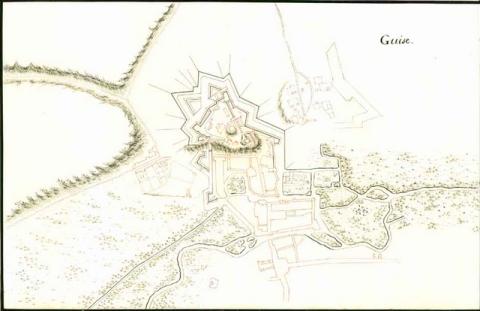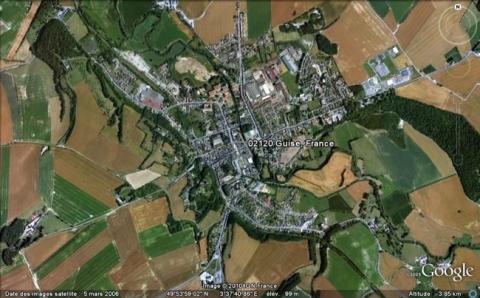Guise
History and description
Agglomeration of Merovingian origin, Guise has had a castle since the 10th century. It was in 945 that the town became a fiefdom. Devastated during the war between the King of France Philippe Auguste and the Count of Flanders, Guise was taken by the royal armies. From 1185 to 1191, the castle was renovated for the first time. During the Hundred Years War, the castle was subject to multiple English sieges but was only conquered on one occasion, in 1424, by them and their ally Jean of Luxembourg. After this capture, which was followed by the restitution to the regime of Charles VII of France, the castle was progressively renovated between 1430 and 1457. The French targeted the construction which had been started by the English and their allies. From 1482, Guise became part of the first line of defence for France under Louis XI against the Netherlands Burgundians followed by those from Habsburg. It was besieged multiple times, including a siege led by Charles Quint in 1536. It was not returned to France until 1542. At this time, the castle, the only fortification of Guise, was ruined. This state of ruin prompted Francis I to order its restoration and modernisation in 1547, shortly before his death. The modernisation was implemented by Captain Claude de Lorraine in 1549. He constructed five bastions and dug out dry moats around the medieval castle. Two ravelins were added to the south. The town remained without any ramparts but the northern bastions, separate from the body of the fortification, were connected to it. Inside, the collegiate was restored and a seven storey barracks was constructed. Intended for three thousand soldiers, it was named the building of Three Thousand. An arsenal, a governor’s residence, quarters for officers and a state prison were also constructed. The bastions of the castle included casemates and corridors for communications with musket firing loops. The construction was completed in around 1552. The three sieges that followed (1594 during the Religious wars, 1636 during the Thirty Years war and 1650 during the Fronde) were each followed by repairs only, without any fresh work. In 1659, the treaty of the Pyrenees rubber stamped the capture by France of Avesnes-sur-Helpe, Landrecies, Philippeville and Mariembourg, which meant Guise was downgraded in status to part of the second line of defence in France.In 1673, when he drew up the Pré Carré, Vauban did not initially include Guise, deeming it to be useless. Louvois, the War Minister, disagreed and sent him on an on-site visit on 19 January, 1673. After this visit, Vauban decided it should be preserved. However, once again there was no addition, but only repairs made, from 1673 to 1683. The terraced sections of the ramparts and the glacis were remade, the ravelins were remodelled, the gates were restored and the moats were widened. However, the outlines remained unchanged and were those designed by the Captain of Lorraine a hundred and thirty years earlier. This is due to the fact that the castle of Guise was once again downgraded, this time into third-ranked status, in terms of the defence of France. Established in 1678, the Pré Carré did not include it except as a rear location with weak fortification. Vauban preferred to focus on the defensive installations further north.
During the 18th and 19th centuries, the castle did not undergo any significant modifications, other than covering the barracks with earth to improve the anti-bombardment protection. Otherwise, the work carried out was limited to the maintenance of existing parts. Repairs were made after the Prussian siege of 1815. Ravaged by allied bombardment in October 1918, shortly before the liberation of the town by the French, Guise castle was downgraded as a war location in 1922 and sold by the army to a private individual, who transformed it into a quarry and landfill.
Current state
The castle of Guise still stands, although it has been used as a quarry and landfill site for thirty years. Since 1953, Le Vieux Manoir association, founded by Maurice Deton, has proceeded with its restoration via the efforts of young volunteers. A museum has also been created in the casemates of one of the three surviving bastions: the bastion de l’Alouette. This museum describes the evolution of arms over the thousand years having passed since the castle was built and the daily life within it over the course of this thousand year period. The two other surviving bastions, the bastion de la Vieille Ville and the bastion de la Charbonnière, have been restored and can be visited by applying to ASBL. The medieval keep, a watchtower and the state prison are also still to be found. Of other internal constructions (barracks and collegiate church), all that is left is foundations and occasionally cellars. Part of the defensive walls was demolished for safety reasons in the year 1950.
Guise
Guise
49° 53' 53.637" N, 3° 37' 34.5151" E
Type
castle, then a fort
Department
Aisne
Region
Hauts-de-France
Bibliography
- Le château des ducs de Guise, site officiel, http://chateaudeguise.free.fr/index.php?rubrique=accueil.
- Le château fort de Guise, dans Bulletin des Amis de la Citadelle de Namur, Jambes, s. d.
- FAUCHERRE (N.) et HANSCOTTE (F.), La route des fortifications en Nord, Paris, 2007, éd. le Huitième Jour, coll. Les étoiles de Vauban.

